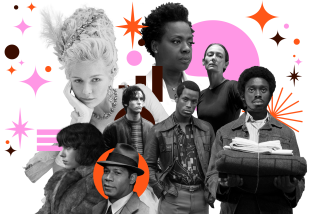‘VAMPIRE,’ ‘ROAD BACK’ SET AT UCLA
- Share via
Tod Browning’s “Mark of the Vampire” (1935) and James Whales’ “The Road Back” (1937) (UCLA Melnitz on Thursday at 8 p.m.) find neither director in top form yet as intriguing as ever. “Mark of the Vampire,” which is a remake of Browning’s lost “London After Dark” (1927), suggests that it probably was lots more convincing in its original silent version than in this rather stilted talkie dominated by Lionel Barrymore’s hammy hypnotist-sleuth.
Still, “Mark of the Vampire” is lots of fun (as camp) and has its eerie effects, thanks largely to the superb black-and-white images of cameraman James Wong Howe. In essence, the film is a murder mystery which just happens to be set in Transylvania. Is the killing of Sir Karell Borotyn (Holmes Herbert) the work of a vampire or did a more mundane murderer simply make it look that way? In the original, Lon Chaney played both Barrymore’s role and that of Bela Lugosi (as . . . guess what?).
“The Road Back” is a little-known sequel to the anti-war classic “All Quiet on the Western Front,” an ambitious, handsome large-scale saga of Germany’s World War I soldiers returning home to a country in turmoil. “The Road Back” seems to be working up to a cautionary fable that might have been as prophetic as Renoir’s “Grand Illusion” or “The Rules of the Game” but reportedly was sabotaged by Universal’s front office bowing to pressure from Hitler’s Germany, which threatened to boycott all of the studio’s pictures unless this one was softened.
The victim of this uneven film was Whales, whose career thereafter took a downward spiral even though “The Road Back” in its wide scope and many strong moments suggests that Whales actually possessed a far wider range than his famous horror films suggest.
The Films of Burt Lancaster, a two-month, 30-film retrospective honoring one of Hollywood’s most enduring and respected stars, commences Friday at 1 p.m. and again at 8 p.m. in the County Museum of Art’s Bing Theater with “Elmer Gantry” (1960), the film that won Lancaster his Oscar as Sinclair Lewis’ phony evangelist, and “The Killers” (1946), which marked his screen debut in a full-fledged starring role.
Lancaster started at the top and has managed to stay there. After a lull in the early ‘70s, he came back strong with “Go Tell the Spartans” (1978), one of the best yet most neglected Vietnam War movies that features a comic scene with Lancaster that should become a classic. He topped that performance in 1981 with “Atlantic City,” which brought him an Oscar nomination for his portrayal of an aging small-time crook.
Directed by Robert Siodmak and based on an Ernest Hemingway short story, “The Killers,” like its star, wears very well indeed. One of the earliest films noir , it opens with Lancaster, a one-time ring contender and now a service station attendant in a small New Jersey town, refusing to run away from the hit men who’ve been on his trail for years.
Lancaster’s story unfolds in flashback as dogged insurance investigator Edmond O’Brien starts tracing the ex-fighter’s troubled past, which turns up sultry shady lady Ava Gardner (in her first major role). In this bleak, terse and engrossingly fatalistic film Lancaster commands the screen from his first scene.
A 20-film Bette Davis series, focusing on her Warners’ period, commences Sunday at the Nuart with “The Petrified Forest” (1936), “Kid Galahad” (1937) and “Bordertown” (1935). The best bet here is the first, adapted from the Robert Sherwood play, most memorable for Davis’ pretty, imaginative waitress who is encouraged in her dreams by world-weary traveler Leslie Howard. It’s one of Davis’ least mannered, freshest portrayals.
More to Read
Only good movies
Get the Indie Focus newsletter, Mark Olsen's weekly guide to the world of cinema.
You may occasionally receive promotional content from the Los Angeles Times.








